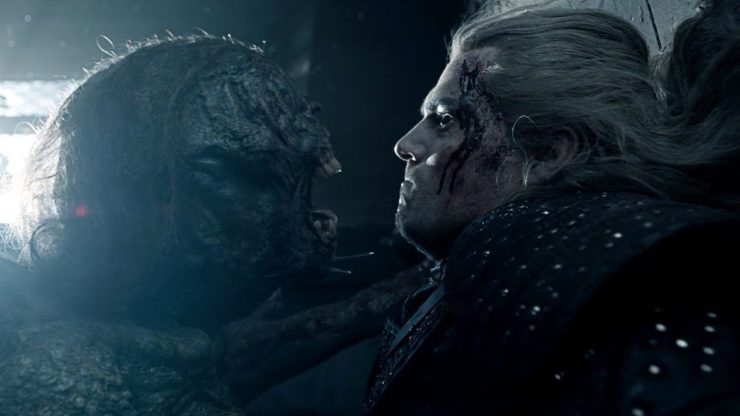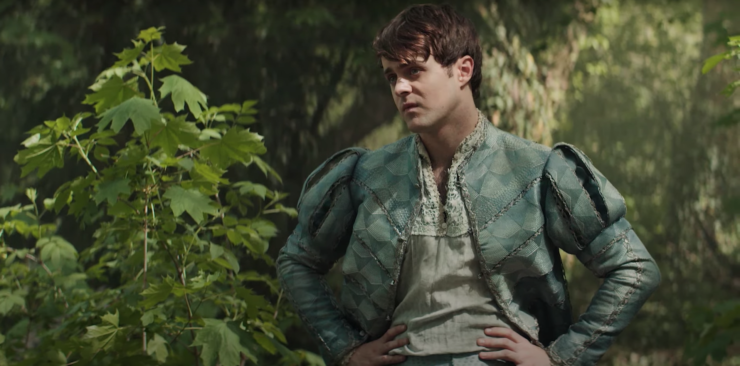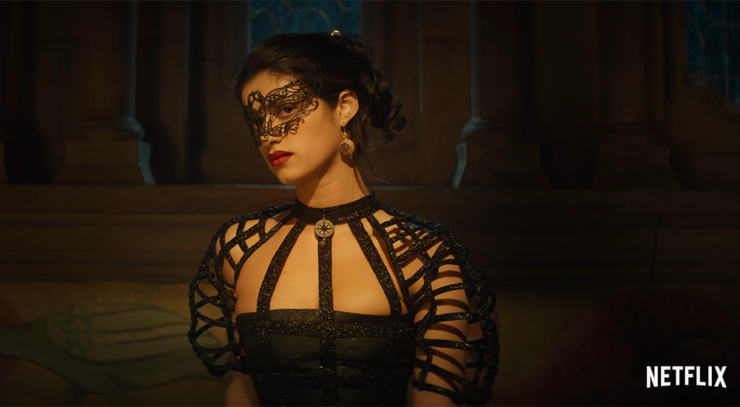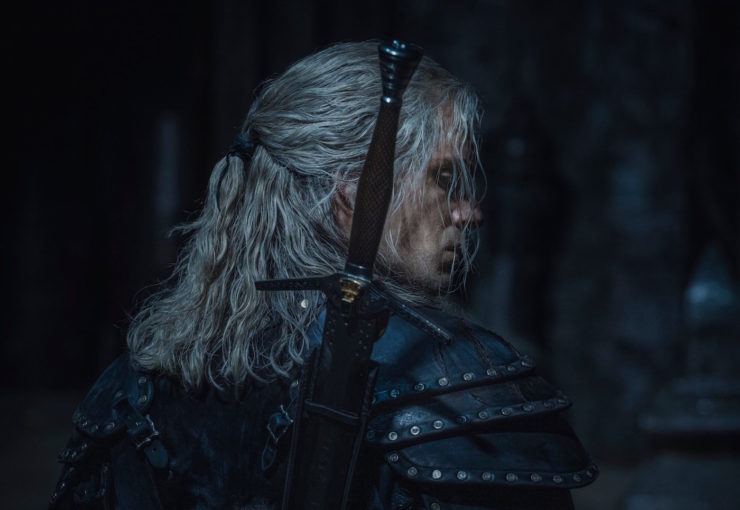Last December, the Netflix adaptation of The Witcher series by Andrzej Sapkowski hit TVs and laptop screens everywhere—and it was renewed for a second season even before the first premiered. Netflix producers must have felt a bit of pressure when it came to adapting the books for television. After all, Sapkowski’s series boasts legions of fans around the world, while CDProjektRed’s action RPG The Witcher III: Wild Hunt (based on the books) is regularly described as one of the greatest video games ever made. It’s probably fair to say that your overall enjoyment of the Netflix series was skewed by whether you’re a book fan, a fan of the games, or both—or whether you’d never encountered the Witcher at all before watching the first episode.
Henry Cavill’s performance as monster-slaying Geralt of Rivia received plenty of praise from viewers and critics alike. It’s no secret that Cavill is a huge fan of both the books and the games—he’s previously described himself as a “proper geek” and even confessed to hounding his agents about setting up an audition for the role. This kind of passion for the character doubtless helped him “inhabit the role in every respect,” as one critic put it. Meanwhile the original soundtrack by composers Sonya Belousova and Giona Ostinelli was also a highlight, drawing on an eclectic mix of folk and popular music, as were the performances by Anya Chalotra as Yennefer and MyAnna Buring as Tissaia de Vries.
Less impressive were some of the adaptations of the short stories that formed the basis of season one. Many of the tales we saw onscreen are drawn from Sapkowski’s collections of short stories, The Last Wish and Sword of Destiny. The first episode depicted the events of “The Lesser Evil,” one of the most famous Witcher tales, in which Geralt gains and unfair reputation across the Continent as a cold-hearted killer, the so-called “Butcher of Blaviken.” Unfortunately in the TV series, the true complexity of this story was completely missing. No mention is made of Renfri’s sadistic plan to try and right her own grievances with Stregobor by taking innocent people hostage and then killing them one by one, leaving the moral of the tale feeling a little hollow.
A similar claim could be made of the writers’ decision to completely omit Geralt and Ciri’s initial meeting in the elven stronghold of Brokilon—a fan favourite moment and also the perfect explanation as to why Ciri is considered to be Geralt’s destiny. Overall, important plot points went missing, which left the Witcher universe feeling a little less interesting than it could have been.
So what will season two bring for Geralt, Yennefer, and Ciri? Showrunner Lauren Hissrich has revealed that the upcoming series will focus on the events of Blood of Elves, Sapkowksi’s first full-length Witcher novel. We’ve already been treated to some glimpses of Kaer Morhen and the Temple School in Ellander, thanks to the teasers that were released during this year’s Witcher Con. Let’s look beyond what we’ve already seen hinted at, so far, and discuss what Witcher fans are dying to see in this next series—from more of the characters and themes we encountered in season one to some aspects of the books we’ve not encountered yet at all…
More nuanced characters and factions

One of the greatest achievements of Sapkowski’s fantasy series is his ability to portray complex characters that inhabit a deeply nuanced world. It’s often hard to pin down truly “good” people in the books and stories; as Geralt himself observes, in this world “people like to invent monsters and monstrosities. Then they seem less monstrous themselves.” But this dubious morality on the part of the characters is often due to the dire external forces working against them, such as poverty and war. Ciri, for example, is certainly no Mary Sue, always getting her way, automatically being highly skilled at everything, and never encountering any real obstacles. As book readers well know, her character arc is long and arduous, and at times she becomes unrecognisable due to the trauma she undergoes. This complexity also plays out within the various factions and kingdoms we encounter on the Continent.
Nilfgaard is an excellent case in point. In season one, we didn’t get to see too much of the gold and black legions from the South, save for some battle scenes around Cintra. So alongside the exciting new Nilfgaardian armour we’re going to glimpse in series two, it would also be great to see these people padded out in other ways! After all, Emperor Emhyr’s aggressively expanding nation is no one-dimensional Galactic Empire. In Sapkowski’s world, Nilfgaard is more tolerant of magic than other kingdoms and a significant percentage of their population is descended from elves. Furthermore, Nilfgaardian soldiers are human beings, ordinary people who just want to survive their next campaign.
Cahir is the most notable example of this, and it will be interesting to see the extent to which his character mirrors the development we see in the books. At first he is a mysterious, alarming figure, defined solely by the winged helmet and black armour which plague Ciri’s nightmares. By the end of the series he is a noble hero, fighting desperately for the people he loves. Lauren Hissrich decided to introduce Cahir far earlier than expected, so in season one we see a slightly different side to him as Cahir the ambitious Nilfgaardian commander—he is more fleshed out, warts and all. However, this decision may well help to establish as strong foundation for his fascinating character arc in later seasons.
More monster hunting!

Who doesn’t want to see more monster hunts? (Well, perhaps not the show’s accountant—all that CGI!)
Watching Geralt at work was one of the highlights of season one. The very first scene of the Netflix series really helped to set the tone by depicting Geralt nearly drowning under the weight of a spider-like creature known as a kikimora. Meanwhile, the bulk of episode three—“Betrayer Moon,” arguably the most enjoyable installment of the first series—followed Geralt’s bid to unravel the mystery of a cursed princess, who had transformed from a tiny foetus into a formidable strzyga. Other creatures who were either referenced or appeared briefly on screen included sylvans, ghouls, and bruxae.
Luckily for fans, it looks as though even more time will be devoted to Geralt’s endeavours in the upcoming series. Online sleuths already guessed earlier this year that the White Wolf’s encounter with the bruxa Vereena in The Last Wish will be brought to life on the small screen; later, this was confirmed by a brief clip from the new trailer which appears to show Vereena in action, circling through the air in her true vampiric form.
Why do we want to see even more monsters in the second season? Among other things, monster hunting helps to emphasise the stark differences between witchers and humans. Although witchers are humanoid creatures—they used to be fully human once—their bodies are starkly altered during their training. The infamous “Trial of the Grasses” involves young trainees absorbing all manner of herbs and elixirs into their bloodstream over the course of a week. Most end up dying by the third day; as Queen Calanthe asks Geralt, “How many youngsters ultimately receive medallions and silver swords? One in ten? One in twenty?” The minority who do survive possess lightning-fast reflexes, heightened senses, enhanced strength, and undergo a far slower ageing process than the average human. In other words, they become the perfect instrument for slaying hideous creatures that humans themselves dare not confront. On top of these changes, witchers also learn how to brew potions that temporarily enhance their abilities in battle—this is why we see Geralt’s eyes drained black when he’s fighting the kikimora in the Netflix series. Witchers can even perform basic magic to conjure shields or cause fire damage.
Unfortunately, all of these differences engender a deep sense of mistrust from the human populace. In the books we’re often reminded just how unique the witcher class is thanks to the various excerpts of in-universe texts that appear at the start of each chapter. But we also witness the darker consequences of these differences too, with many villagers eager to label Geralt a freak and a mutant, despite the fact his silver sword may have just saved them from a bloodthirsty monster. Some critics of the Netflix series have pointed to the lack of worldbuilding as one area that could be improved upon, going forward. Showing Geralt and his fellow witchers in their professional capacity illustrates what a dark and dangerous place the Continent is for most people, especially on the road. But it is also an opportunity to highlight the hostility towards witchers that runs deep through the peasants of the Continent, as well as Geralt’s acceptance that he will always be an outsider.
The many sides of Jaskier (aka Dandelion)

In the Witcher books, Geralt’s best friend Jaskier is one of the bright spots amidst the wastelands of the war-torn Continent. We first meet him at a festival in Aedirn where, in classic Jaskier fashion, he’s trying to escape the clutches of four brothers who want to punish him for impregnating their sister. The witcher and the bard make an unlikely pairing, but the bond of friendship they develop over the course of Geralt’s adventures is a warming reminder that hope and positivity do exist, and that genuine human connection can be a powerful force to lean upon when life becomes difficult. Joey Batey’s performance as Jaskier split fans of the books, with many praising his musical ability and humor, while others argued that his mannerisms and delivery didn’t seem to quite fit with the rest of the world we were experiencing.
Whichever side of the fence you’re on when it comes to Jaskier, the series does a good job of establishing the pair’s unique chemistry. And judging from the trailers we’ve seen so far for season two, we can definitely expect to see more of Batey’s musical prowess on display. But along with his skills as a bard, it would be great to see Geralt’s friend fleshed out further by highlighting other aspects of his personality, particularly his loyalty and the bravery which grows from this trait…
The beauty of Jaskier is that while he is an excellent comic foil to Geralt’s brooding nature, he has various other facets to his character which all feed into his unique personality. Jaskier certainly isn’t one to jump straight into the jaws of danger without thinking. Yet there are several occasions when he steps up to the mark for the sake of Geralt, Ciri and even Yennefer. In Blood of Elves, Dandelion is captured by a wizard named Rience who is desperately looking for Ciri. Despite being tortured, he refuses to reveal her whereabouts; he is likely about to be killed when Yennefer appears and fights off the mage.
It’s also important to remember that Jaskier is considered a supremely talented bard across the Continent. The small-screen adaptation depicts Jaskier mainly playing in taverns, with a brief appearance at the Cintrian court. However, in the books, much of his time is spent in the company of nobility, from Toussaint to the Skellige Isles. The Witcher universe is full of sorcerers and sorcereresses, witchers and warriors who have physical or magical strength on their side. Jaskier is an excellent example of a character who derives his power from his talent and voice, which saves his skin (or at least buys him time!) on more than one occasion. We can’t wait to see how the series will show that there’s so much more to the bard in season two.
The politics of the Northern Realms

The Netflix series has already begun to portray a little of the unique nature of politics on the Continent, which is intertwined with the influence of powerful sorcerers and sorceresses. Viewers watched Yennefer’s ascension to power and her boredom with courtly life, as well as Fringilla Vigo’s role in the Nilfgaardian invasion on Cintra. We also saw some snippets of the Lodge of Sorcerers in action, figures who are portrayed as the real puppet masters behind many of the rulers on the Continent.
Politics is often used as an essential part of worldbuilding in high fantasy, and more of an emphasis on this in season two would help to illustrate who is fighting against Nilfgaard, why the Northern realms are battling for survival, and the ways in which the different countries are distinct from one another. So far we’ve had little sense of Geralt and company’s journeys across borders, save for an introduction to King Foltest and the kingdom of Temeria in episode three. Otherwise it was mostly left up to viewers to try and determine who was feuding with who, which wasn’t always entirely clear. Cintra was highlighted as an important location in the battle with Nilfgaard, but viewers never really got to understand its history, the significance of Queen Calanthe as the infamous “Lioness,” and how its capture would affect neighbouring provinces such as Brugge and Nazair. Game of Thrones introduced its various competing factions very early on in the show’s production, and The Witcher would benefit from a similar treatment in its second season.
Furthermore, it will be interesting to see how Lauren Hissrich and the show’s writers treat witcher neutrality. It’s inevitable that we’re going to see Kaer Morhen and the School of the Wolf in season two. What’s going on in the outside world does impact the witchers, and they carefully hide the path to their keep from passing armies; the witchers previously suffered a massacre at Kaer Morhen, besieged by hordes of fanatics who believed they were abominations. And yet witchers abide by a rigid code of political neutrality. They try to confine their actions to killing monsters, rather than slaying people that other humans consider to be monsters. In Blood of Elves, Geralt teaches Ciri his own interpretation of neutrality, and scolds her when she insists she is training to fight in order to kill the Black Knight haunting her dreams. Witchers don’t learn to kill “out of fear or hatred, but in order to save lives.” Neutrality does not necessarily mean being a passive bystander, but it does mean learning to resist fighting purely out of revenge or hatred at the actions of a particular group of people. Given the unstable political situation sweeping the Continent, this code is regularly put to the test.
Travel across a grittier landscape

Readers of Sapkowski’s books would probably agree that we experience a great deal of Geralt’s universe from the road, as the characters travel constantly and are mounted on horseback for much of the time. For example, the vast majority of Ciri’s journey sees her on the run. She travels with Geralt and Yennefer to Kaer Morhen, Ellander, and beyond; when she eventually joins the Rats her life becomes that of a common bandit, riding from village to village. Eventually she meets the sadistic bounty hunter Leo Bonhart, who drags her across the Continent in pursuit of his sick ambitions. Furthermore, as a typical witcher, Geralt spends half his life on the road—he’s used to sitting in the saddle, constantly seeking out work to make sure he can afford a mug of ale and a bowl of potato soup at the end of the day.
And what do our many characters encounter on the road? Unfortunately for Netflix, a lot of it probably isn’t fit for a TV-MA rating. Torture, rape, pillaging, and slavery are just some of the many ugly realities of war that take their toll on the landscape (and help to explain why many humans are so bitter and suspicious of outsiders). In season one, Geralt appeared to enter a number of villages, but we didn’t really get a sense of his journeys between those locations and how they illustrate the devastating effects that warfare is having on the countries he visits. Glimpses of a grittier landscape would help to emphasise how battles between nations affect the common people who are forced to suffer through conflicts they haven’t asked for, while providing another key opportunity to engage in some valuable worldbuilding along the way.
***
Overall, it’s going to be really exciting to see how the showrunner and writers portray the Witcher universe in Season Two. Sapkowski’s world is so rich and detailed, and there are plenty of things we would love to see on top of the list above. For instance, it would be great to see how the Scoia’tael bandits and their storyline help to expand what we know about the history of elves on the Continent. We should also get to see how Rience receives his infamous facial scar at the hands of Yennefer, as well as meet Yarpen Zigrin’s company of dwarves on the road. And of course, fans will be hoping that the hilarious “Dear friend…” letter Geralt receives from a certain dark-haired sorceress will make an appearance…
Are you a fan of The Witcher books? If so, which moments and elements from the books, stories, or games would you like to see in season two of the series?
Rachel lives in Edinburgh and was recently awarded a journalism internship. She has previously written about pop culture, books and philosophy for publications such as History Today and Electric Literature. Loves reading, gaming and anything to do with the 16th century. You can find her author bio here.










